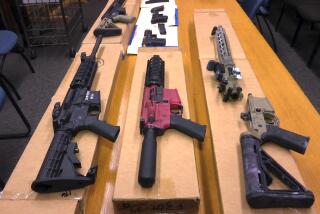Federal court restricts Taser use by police
- Share via
A federal appeals court this week ruled that a California police officer can be held liable for injuries suffered by an unarmed man he Tasered during a traffic stop. The decision, if allowed to stand, would set a rigorous legal precedent for when police are permitted to use the weapons and would force some law enforcement agencies throughout the state -- and presumably the nation -- to tighten their policies governing Taser use, experts said.
Michael Gennaco, an expert in police conduct issues who has conducted internal reviews of Taser use for the Los Angeles County Sheriff’s Department and other agencies, said the ruling by the U.S. 9th Circuit Court of Appeals prohibits officers from deploying Tasers in a host of scenarios and largely limits their use to situations in which a person poses an obvious danger.
“This decision talks about the need for an immediate threat. . . . Some departments allow Tasers in cases of passive resistance, such as protesters who won’t move,” he said. Tasering for “passive resistance is out the door now with this decision. Even resistance by tensing or bracing may not qualify.”
The weapons, which resemble handguns, can be fired from about 20 feet away and project two dartlike electrodes. The electrodes send an electrical charge coursing through the target -- a shock that temporarily paralyzes the person’s muscles and causes extreme pain. Almost all of the stun guns used by law enforcement agencies in the United States are manufactured by Taser International Inc., including the one fired in the current case.
Though stun guns have been in use for about three decades, the number of police departments issuing them to officers has proliferated in the last 10 years. Advocates tout the weapons as a less-than-lethal alternative to firearms and say they help resolve dangerous face-to-face confrontations with combative suspects. But several controversial Taser incidents, some involving fatalities, have led to widespread debate over when police should be allowed to deploy the weapons.
Last year, a National Institute of Justice study found that the weapons were employed safely in the vast majority of cases, but concluded that more research is needed to determine the health effects of shocking small children and the elderly, among other groups.
The unanimous ruling, issued Monday by a three-judge panel, stemmed from a 2005 encounter in which a former Coronado, Calif., police officer, Brian McPherson, stopped a man for failing to wear a seat belt while driving. The driver, Carl Bryan, who testified that he did not hear McPherson order him to remain in the car, exited the vehicle and stood about 20 feet away from the officer. Bryan grew visibly agitated and angry with himself, but did not make any verbal threats against McPherson, according to court documents. McPherson has said he fired his Taser when Bryan took a step toward him -- a claim Bryan has denied.
Bryan’s face slammed against the pavement when he collapsed, causing bruises and smashing four front teeth.
The appellate court did not rule on whether McPherson acted appropriately, but simply cleared the way for Bryan to pursue a civil case against the officer and the city of Coronado in a lower court. Based on Bryan’s version of events, though, the judges found that McPherson used excessive force in firing the Taser, since Bryan did not appear to pose any immediate threat.
In spelling out their decision, the judges established legally binding standards about where Tasers fall on the spectrum of force available to police officers, and laid out clear guidelines for when an officer should be allowed to use the weapon. The judges, for example, said Tasers should be considered a more serious use of force than pepper spray -- a distinction that runs counter to policies used by most law enforcement agencies in California and elsewhere, according to Greg Meyer, a retired Los Angeles Police Department captain and consultant on use-of-force issues.
The ruling does not appear to affect the LAPD, which has a relatively strict policy on Taser use. Gennaco said that the same is more or less true of the Sheriff’s Department, but that he would discuss with Sheriff Lee Baca the possible need for “tweaking” the policy and training.
The Orange County Sheriff’s Department seems more likely to be affected. Spokesman John McDonald said the department’s policy allows officers to fire Tasers at people who try to flee an encounter with police or who refuse, for example, to comply with an officer’s order to lie down during an arrest. Those scenarios appear to be prohibited under the court’s ruling.
“It sounds like this court is attempting to raise the bar for nonlethal use of force,” Meyer said.
More to Read
Sign up for Essential California
The most important California stories and recommendations in your inbox every morning.
You may occasionally receive promotional content from the Los Angeles Times.














